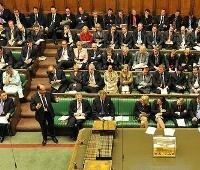UK Trident renewal
Issue:Global militarisation
In the UK, the Conservative-Liberal Democrat coalition government continues to pursue the renewal of Britain’s Trident nuclear weapon system amidst criticism of the opacity of the procurement process and concerns over the substantial and increasing costs of the project. Adding fuel to public anger over widespread government cuts, the Defence Secretary Liam Fox’s long overdue announcement in May 2011 that the Initial Gate for the project had been approved was accompanied by the revelation that when inflation is taken into account the price tag for just the new submarines (excluding missiles, warheads and running costs) is likely to be £25 billion, as opposed to the £11-14 billion announced in 2006. With the defence budget already curtailed by the October 2010 Comprehensive Spending Review (CSR) and under strain on account of a projected deficit of £36 billion over the next 10 years, these latest figures have prompted further concerns that Trident is being replaced at the expense of conventional military capabilities. Moreover as the Ministry of Defence (MoD) is now locked in yet another battle with the Treasury pressing questions are being asked about the costs, benefits, priority and opportunity costs of Trident replacement as compared with other areas of government expenditure. On 3 August, the Defence Select Committee - a cross-party committee of MPs -criticised the government over its "rushed" and "badly done" Strategic Defence and Security Review (SDSR). Responding, Jim Murphy, the UK's Shadow Defence Secretary said "events have exposed the mismatch between policy ambition and the resources provided by ministers".
Originally scheduled for September 2009 the Initial Gate announcement, which gave the green light for the next stages of procurement to be undertaken (up to 15% of the budget), had been postponed numerous times whilst decisions were made regarding design, particularly over which type of nuclear reactor to use in the new submarines. The Defence Secretary’s Initial Gate statement in the Commons revealed that the new PWR3 reactor would be used, which will increase costs further. The decision to install the PWR3 instead of the currently used PWR2 reactor in the new subs was based on the results of a safety assessment which was accidentally made public by the MoD when anunredacted version of the report was posted on the internet. This led to criticisms of the MoD as well as of Parliamentary Under Secretary of State for Defence Equipment, Support and Technology, Peter Luff, who contradicted the report in Parliament. Anxieties over safety were amplified when an MoD report was published that assessed that government funding cuts are likely to jeopardise the safety of the UK’s nuclear weapons. Likewise, an official inquiry into the August 2010 fire at Aldermaston Atomic Weapons Establishment (AWE) contained strong criticism of the private management consortium (AWE plc, comprising US arms dealer Lockheed Martin, SERCO and Jacobs Engineering) that runs this publicly-funded nuclear weapons plant, particularly with regard to fire prevention and response. The report led the government's Health and Safety Executive to investigate whether to take legal action against the AWE Management group. Nonetheless, despite a catalogue of problems associated with private sector management of AWE and other UK nuclear sites, in May the Scottish Herald revealed that the nuclear warhead storage base at Coulport is to be sold off to a consortium of private companies also led by, Lockheed Martin.
The statement on the Initial Gate was accompanied by the publication of areport describing work on the Trident renewal programme to date, the decisions taken at Initial Gate and around £3 billion of work scheduled to take place in advance of the Main Gate. Dr Fox also identified spending on long lead items that would cost a further £500 million. Alongside the announcement came the news that, in line with the Coalition Agreement under which it was agreed that the Liberal Democrats could continue to make the case for alternatives, an18-month study to review the “costs, feasibility and credibility of alternative systems and postures” would be undertaken. The study will be conducted by the Cabinet Office and overseen by Armed Forces Minister and Liberal Democrat Nick Harvey who is more open to exploring alternatives to Tridentthan his senior colleague, Conservative Defence Minister Liam Fox, who hasmade it clear that he is absolutely opposed to change. By way of compromise, the study will consider only nuclear weapons options for replacing the role assigned to Trident in the UK’s nuclear deterrence posture, with no consideration of non-nuclear options for deterrence and security. In Scotland meanwhile, following the May 2011 elections which gave the Scottish National Party (SNP) a strong working majority in the Scottish Parliament, a resolution is to be tabled calling for the removal of UK nuclear weapons from Scottish territory. If successful, such a resolution could have far-reaching implications for the storage of nuclear warheads at Coulport and the deployment of Trident, currently homeported at the MoD’s naval base at Faslane.
In spite of his unswerving commitment to replacing Trident, Liam Fox was keen to stress the UK’s disarmament credentials on the occasion of the ‘P5 follow-on meeting to the 2010 NPT Review Conference’, using the opportunity to confirm that part of the warhead reduction announced by the UK’s most recent Strategic Defence and Security Review (SDSR) has been completed. Not long afterwards, former UK Foreign Secretary Margaret Beckett reignited the debate over the policy of Continuous-at-sea-deterrence (CASD) when she raised the possibility of “not necessarily needing four boats”.
Article source: The Acronym Institute
Image source: UK Parliament
 Delicious
Delicious Digg
Digg StumbleUpon
StumbleUpon Reddit
Reddit
Posted on 11/08/11

Comments
Post new comment